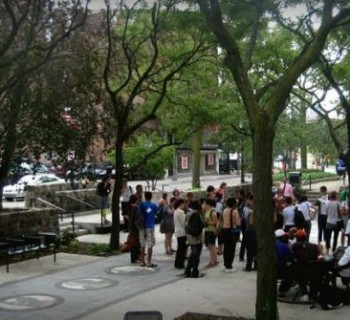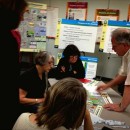DETROIT—This fall, more than 20,000 tax foreclosed properties were auctioned off by the Wayne County Treasurer’s office, of which more than 18,000 were located in the City of Detroit. As the “world’s largest property auction” in a city struggling with widespread economic and social justice issues, there was bound to be a stir.
Last Wednesday, more than 300 people convened at Café Con Leche del Este’s pop-up in Lafayette Park to talk about the auction in a community forum. Model D and UIX hosted the event “No Property Left Behind,” which was presented by Jerry Paffendorf and Alex Alsup ofLOVELAND Technologies and Detroit Revitalization Fellow Erin Kelly. Chief Deputy Treasurer David Szymanski was also in attendance.
The crowd seemed to represent every kind of Detroiter effected by the auction – people who bought properties, people who lost properties or are currently threatened with foreclosure, housing advocates, city officials, concerned neighbors, curious onlookers, and everyone in between.
With roughly 5 percent of the city’s properties on the auction block in 2012 and still almost 25 percent in three-year tax delinquency, this is an issue that affects every last Detroiter. Period.
The program’s stated focus was what to do with the 8,000 properties that went unsold in the auction, but that ultimately was the match strike for myriad other burning questions and concerns. While the issue is a daunting one, the event was designed to provide an avenue for constructive discussion.
Topics of every angle were breached – speculation, eviction, scrapping, neglectful owners, opaque city and county governments, you name it. There were even photo comparisons of some of the unsold properties from 2009 and today to highlight how quickly vacant properties can deteriorate into targets for crime and arson.
When asked to comment on ways to combat the issue of properties winding up back in auction on a three year delinquency cycle, Szymanski said there was no way to govern this aspect of the auction. The treasurer’s objective was to simply collect the owed tax. Right now it's a common way for speculators and home owners alike to avoid paying taxes.
This year, $50 million was made on the sale of foreclosed properties, yet only 700 of the approximately 13,000 sold properties were sold for the amount of their back taxes or higher, leaving a more than $220 million tax deficit for the county for just one year.
To combat this tax gap, the Wayne County Treasurer’s Office is working on preventing foreclosures by exploring repayment programs designed to keep people in their homes. Szymanski announced that Troubled Asset Relief Program funds will now be available through the Michigan State Housing Development Authority, which would grant up to $30,000 to homeowners for delinquent taxes.
Despite these ongoing efforts to prevent more properties from entering the cycle, nearly 43,000 properties are already in pre-foreclosure for next year’s auction cycle. While the number of properties that actually make it to the auction will be much less than this number reflects, it is still up from the 34,000 that were in pre-foreclosure this time last year.
Without increased efforts to drastically reduce the foreclosure rate, the world’s largest auction is slated to break its own record in 2013.
Paffendorf with his unfailingly upbeat observation, says “This city has such inspiring problems.”
Despite a lofty $115 million IT budget, city web interfaces are outdated, slow, and lack transparency. So when the county first provided digital data of the auction properties in 2011, Paffendorf’s motley crew of programmers and interface designers started mapping the properties on a website prototype they called Why Don’t We Own This? in an effort to start to track the exchange of foreclosed properties.
For this year’s auction they added features like a comments section and a neighborhood mapping tool to the property pages. The website proved to be so popular that Treasurer Ray Wojtowicz, who had spent $300,000 on billboards as the auction’s main marketing tool in 2012, invited the WDWOT? crew to his office to discuss how to make the auction process more transparent.
Before, Paffendorf said he had to wait until March for the public release of property data for the October auction. Now working with the county, Paffendorf already has access to this information and has begun mapping the 43,000 properties.
Together with Wedge Detroit they are also working on developing a new property template to help owners understand the implications of foreclosure and provide easy tools to help users pay their taxes, get on a payment plan, or reach out for assistance. It will also show when taxes are resolved.
Though the event is over, the conversation continues on the UIX Civic Commons community forum as well as the WDWOT? website, and all are encouraged to get involved.










